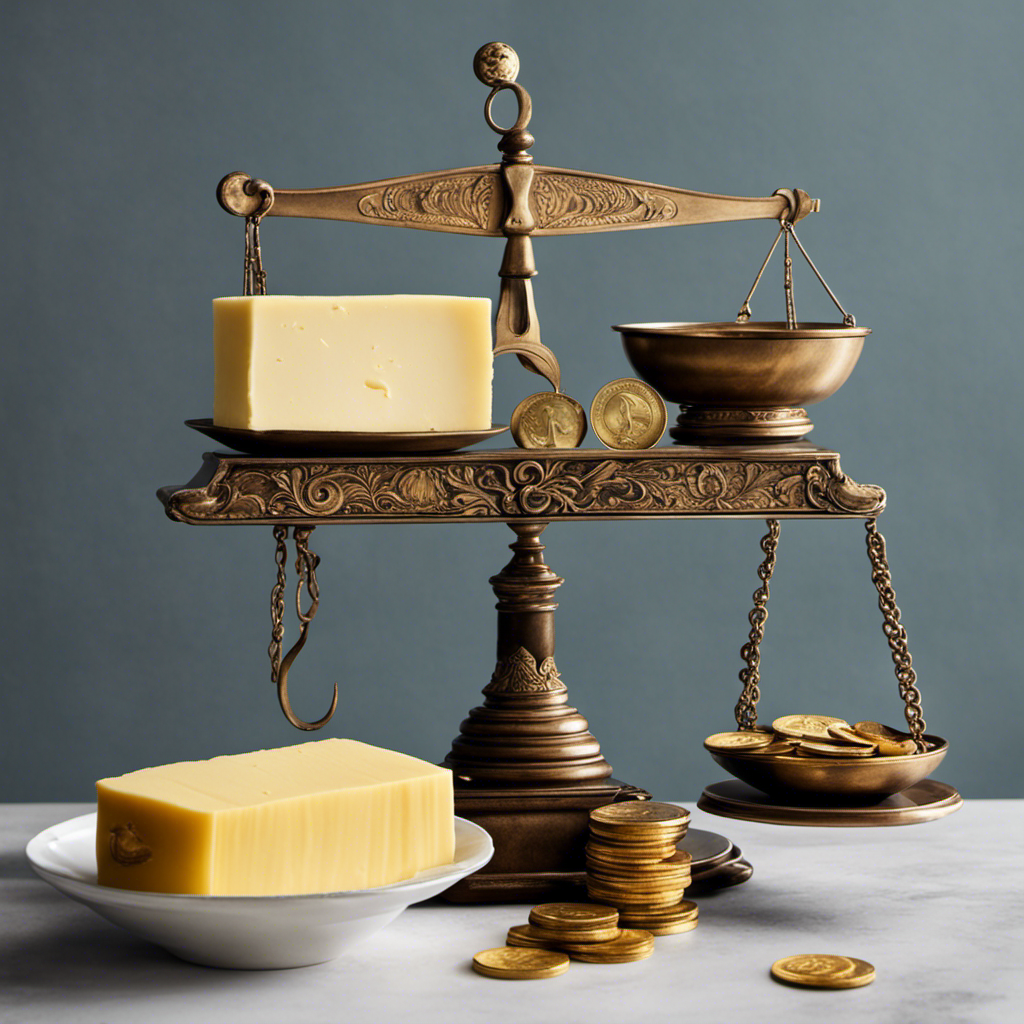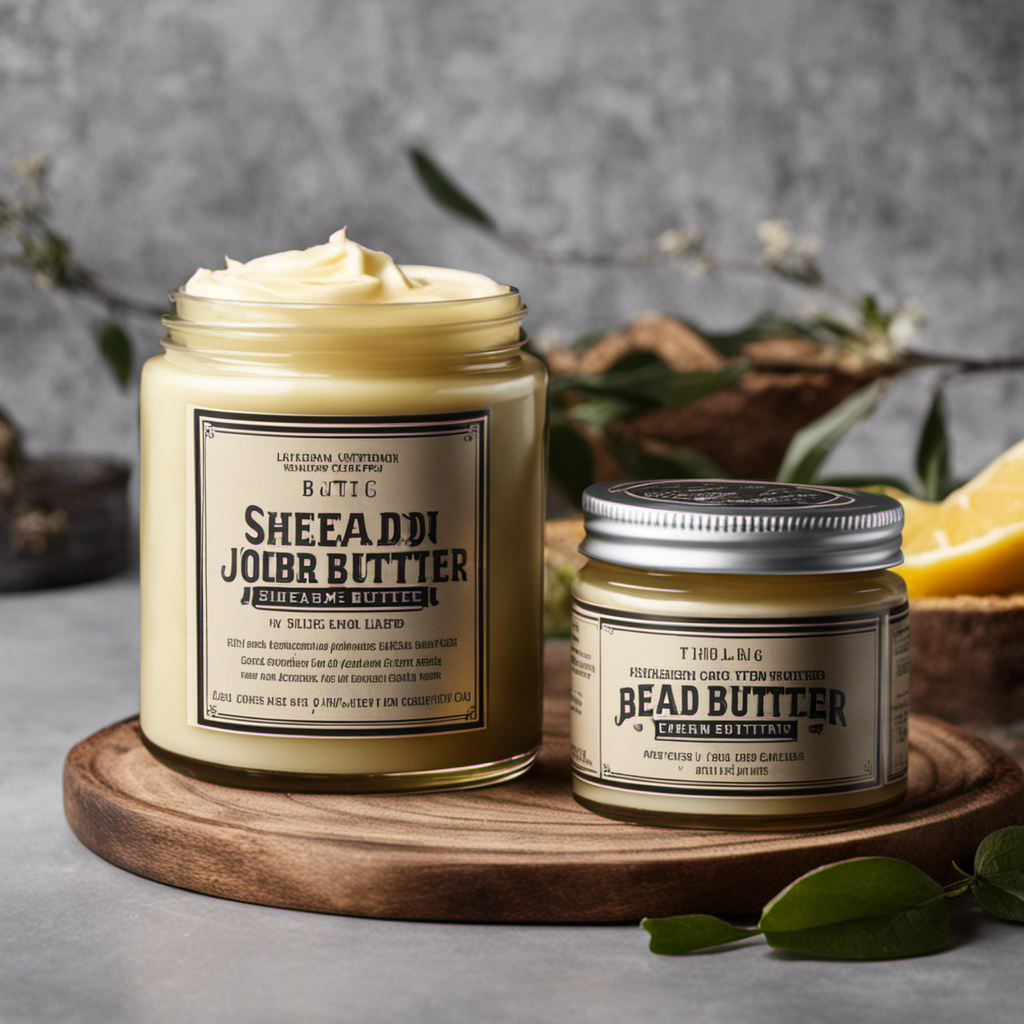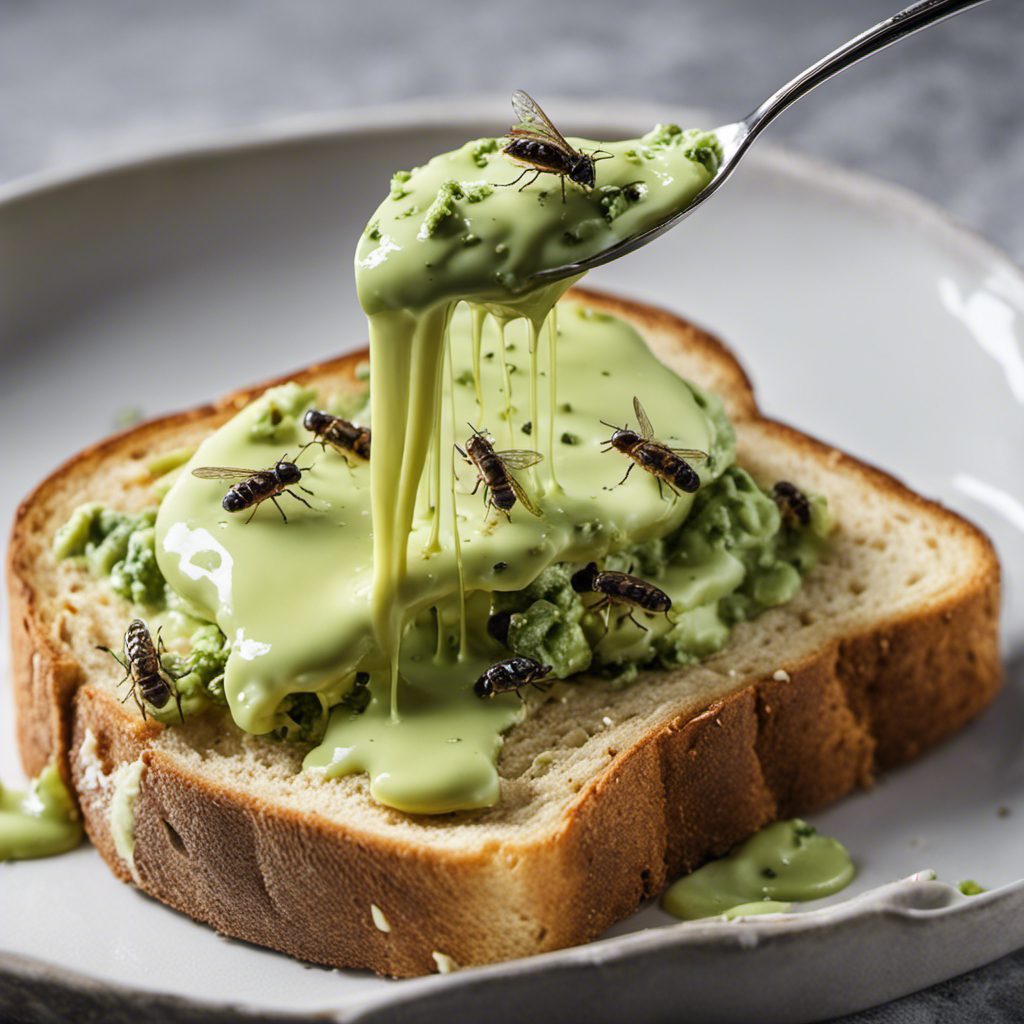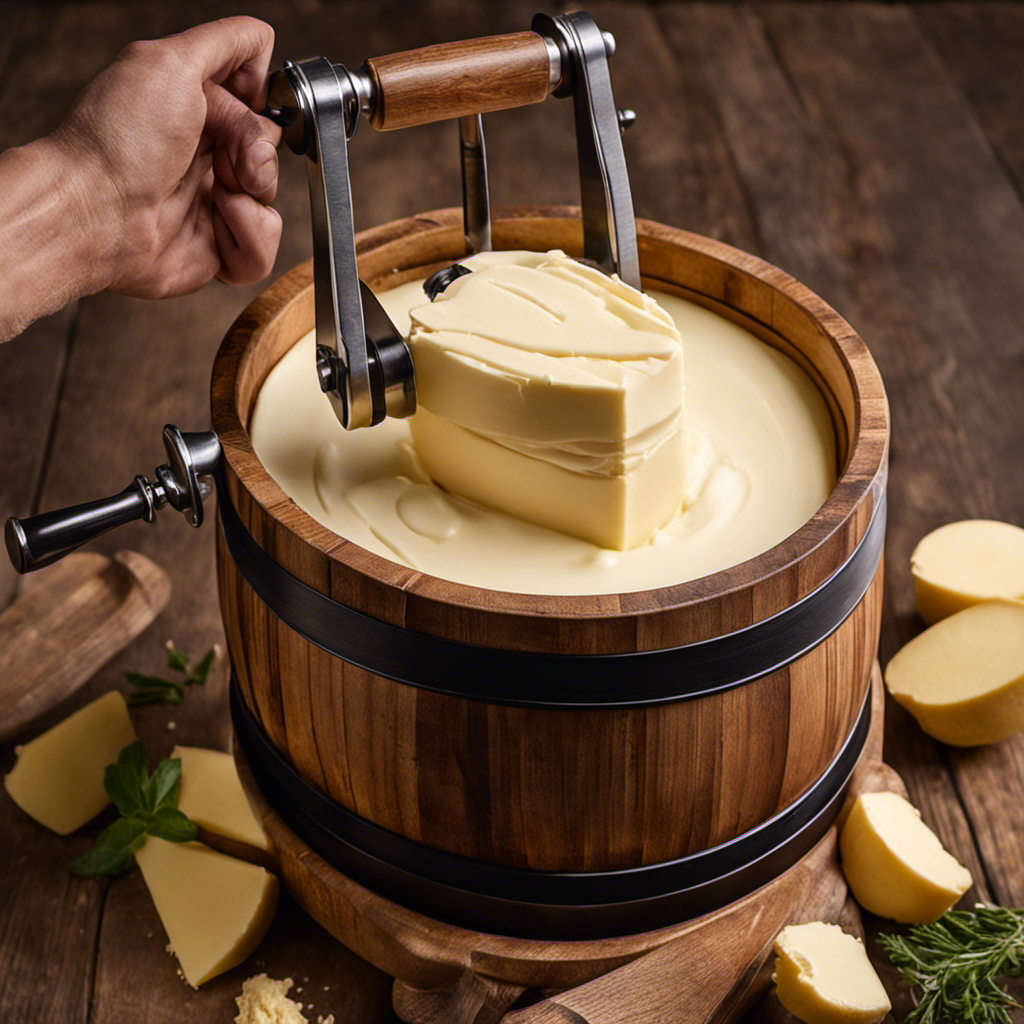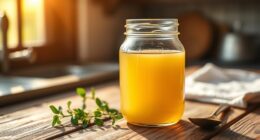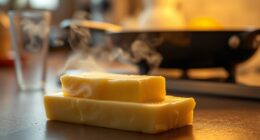Were you aware that incorporating clarified butter into your cooking not only amplifies the taste of your meals but also offers advantages for your health?
As a culinary enthusiast, I have discovered that incorporating clarified butter in my cooking has elevated the taste of my favorite recipes.
In this article, I will delve into the reasons why clarified butter is a staple in my kitchen.
From its unique culinary uses to its impact on traditional Indian cuisine and baking, let’s explore the wonders of this golden, clarified delight.
Key Takeaways
- Clarified butter is lactose-free and suitable for lactose intolerant individuals.
- Clarified butter has a higher concentration of healthy fats and vitamins.
- Clarified butter has a higher smoke point, making it suitable for high-temperature cooking methods.
- Regular butter has a different flavor profile and lower smoke point compared to clarified butter.
Health Benefits of Clarified Butter
The health benefits of clarified butter include being lactose-free and having a high smoke point.
Clarified butter is a form of butter that has had its water content and milk solids removed, leaving behind pure butterfat.
This process not only removes lactose, making it suitable for those with lactose intolerance, but also increases its smoke point, which is the temperature at which the fat starts to break down and emit smoke.
This makes clarified butter ideal for cooking at high temperatures without causing the fat to become rancid or release harmful compounds.
Additionally, clarified butter has been used for centuries in skincare routines due to its moisturizing and nourishing properties.
It is easily absorbed by the skin, providing hydration and promoting a healthy complexion.
Furthermore, clarified butter is believed to improve digestion by stimulating the production of digestive enzymes and promoting the absorption of nutrients.
Culinary Uses of Clarified Butter
One popular way to cook with clarified butter is in baking, where it adds a rich and nutty flavor to pastries.
Clarified butter is a versatile ingredient that can be used in a variety of culinary techniques. Here are three ways to incorporate clarified butter into your cooking:
-
Sauteing: Clarified butter has a high smoke point, making it perfect for sauteing vegetables or searing meats. Its rich flavor enhances the taste of the ingredients while providing a smooth and silky texture.
-
Roasting: Brushing clarified butter on vegetables or meats before roasting helps to lock in moisture and create a golden, crispy exterior. The clarified butter also adds a delicious nutty flavor to the dish.
-
Hollandaise sauce: Clarified butter is a key ingredient in making traditional Hollandaise sauce. Its creamy texture and rich taste elevate the sauce, making it perfect for drizzling over poached eggs or grilled vegetables.
In addition to its culinary benefits, clarified butter also offers nutritional benefits. It contains vitamins A, D, E, and K, and is rich in healthy fats that can support brain health and improve nutrient absorption.
How to Make Clarified Butter at Home
To make clarified butter at home, you’ll need unsalted butter and a saucepan. Clarified butter, also known as ghee, is a versatile ingredient used in many culinary applications, particularly in sauces and cooking methods that require high heat. It is a process of separating the milk solids from the butterfat, resulting in a golden, nutty flavored liquid.
Here’s a step-by-step guide to making clarified butter:
- Start by melting unsalted butter in a saucepan over low heat.
- Allow the butter to simmer gently, ensuring it doesn’t boil.
- As the butter melts, you’ll notice a foam forming on the surface. Skim off the foam using a spoon or a fine-mesh strainer.
- Continue simmering the butter until the milk solids settle at the bottom of the pan, and the liquid turns clear.
- Carefully strain the liquid through a cheesecloth or coffee filter to remove any remaining solids.
By making ghee at home, you can have a pure and flavorful ingredient to enhance your sauces and dishes.
Now, let’s explore the difference between clarified butter and regular butter.
Clarified Butter Vs. Regular Butter: What’s the Difference
When it comes to the health benefits of clarified butter, there are a few key points to consider.
Firstly, clarified butter is lactose-free, making it a suitable option for individuals with lactose intolerance. Additionally, it contains a higher concentration of healthy fats and vitamins compared to regular butter.
As for the cooking advantages, clarified butter has a higher smoke point, which means it can be heated to higher temperatures without burning or smoking, making it ideal for sautéing, frying, and browning. Its longer shelf life and the removal of milk solids also contribute to its cooking advantages.
Health Benefits of Clarified Butter
Using clarified butter, or ghee, can provide various health benefits. Ghee is a form of clarified butter that has been used for centuries in traditional Indian medicine, Ayurveda. It has gained popularity in recent years due to its potential health benefits.
Here are three key benefits of using clarified butter:
-
Clarified butter in skincare: Ghee contains essential fatty acids that can nourish the skin and improve its elasticity. It can be used as a moisturizer, helping to hydrate and soften the skin. Additionally, ghee has antimicrobial properties that can help with skin infections and irritations.
-
Clarified butter as a substitute for oil: Unlike regular butter, ghee has a higher smoke point, making it suitable for high-temperature cooking methods like sautéing and frying. It is also lactose-free, making it a suitable alternative for individuals with lactose intolerance.
-
Nutritional benefits: Ghee is rich in fat-soluble vitamins like A, D, E, and K. These vitamins play vital roles in maintaining healthy skin, bones, and immune function. Ghee also contains conjugated linoleic acid (CLA), a type of fatty acid that has been linked to various health benefits, including reduced inflammation and improved heart health.
Incorporating clarified butter into your skincare routine and using it as a substitute for oil can provide these health benefits and enhance your overall well-being.
Cooking Advantages of Clarified Butter
You can enhance your cooking with the advantages of clarified butter. Not only does it offer health benefits, but it also adds a unique flavor enhancement to your dishes.
Clarified butter is butter that has been melted and had the milk solids removed, resulting in a pure, golden liquid. This process increases its smoke point, making it ideal for high-heat cooking methods like sautéing and frying. The absence of milk solids also means that clarified butter has a longer shelf life and can be stored at room temperature.
Additionally, its rich and nutty flavor can bring a delicious depth to your recipes, whether you’re making roasted vegetables, seared meats, or even baking pastries.
Now, let’s explore how clarified butter is used in traditional Indian cuisine.
Clarified Butter in Traditional Indian Cuisine
In my experience, I’ve found that using clarified butter in traditional Indian cuisine greatly enhances the flavor of curries. The process of clarifying butter removes the milk solids, resulting in a pure, golden liquid with a rich and nutty taste.
This intensified flavor adds depth and complexity to curries, making them more enjoyable and satisfying. Additionally, clarified butter has a high smoke point, allowing for versatility in cooking techniques like frying, sautéing, and even deep-frying without the risk of burning.
Enhancing Flavor in Curries
To enhance the flavor in your curries, try incorporating clarified butter. Clarified butter is a form of butter that has been melted and separated from its milk solids and water content. It is an excellent choice for adding richness and depth to your curry dishes.
Here are three reasons why clarified butter is a great option for enhancing the flavor in your curries:
-
Improved Texture: Clarified butter has a smoother and silkier texture compared to regular butter. This allows it to blend seamlessly into your curry sauce, creating a velvety and luxurious mouthfeel.
-
Enhanced Aroma: The process of clarifying butter helps to intensify its natural aroma. When added to curries, clarified butter imparts a distinct nutty and caramelized fragrance, elevating the overall sensory experience.
-
Alternative to Oil: While many curries are traditionally made with oil, using clarified butter as a cooking fat offers a unique and indulgent flavor profile. It adds a subtle richness and buttery taste that complements the spices and ingredients in your curry.
Incorporating clarified butter into your curries can take your dishes to the next level, enhancing both the taste and overall dining experience.
Versatility in Cooking
When cooking, don’t forget to explore the versatility of different ingredients and techniques to create a wide range of delicious dishes. One key aspect of versatile cooking is the ability to adapt recipes and experiment with different flavors and textures. By being open to trying new ingredients and techniques, you can elevate your cooking skills and create unique dishes that will impress your family and friends.
One technique that offers great versatility in recipes is sautéing. This method involves cooking food quickly in a small amount of hot fat, such as clarified butter. The benefits of using clarified butter for sautéing are numerous. It has a high smoke point, which means it can withstand high temperatures without burning. This allows you to achieve a nice sear on meats and vegetables, resulting in a caramelized exterior and a tender interior. Additionally, clarified butter adds a rich and nutty flavor to your dishes, enhancing the overall taste.
To fully understand the versatility of cooking, let’s take a look at how different ingredients and techniques can be combined to create a variety of dishes. The table below showcases four examples:
| Dish | Main Ingredient | Cooking Technique |
|---|---|---|
| Stir-fried Noodles | Noodles | Stir-frying |
| Grilled Salmon | Salmon | Grilling |
| Roasted Vegetables | Assorted Vegetables | Roasting |
| Pan-seared Steak | Beef Steak | Pan-searing |
As you can see, the possibilities are endless when it comes to cooking. By being open to exploring different ingredients and techniques, you can create a wide range of delicious and satisfying dishes. So, don’t be afraid to experiment and let your culinary creativity shine!
Clarified Butter in Baking: Tips and Tricks
Using clarified butter in baking can bring an extra richness and depth of flavor to your recipes. Here are three ways to incorporate clarified butter in pastries:
-
In pie crusts: Replace regular butter or shortening with an equal amount of clarified butter. The result is a flakier, more tender crust that melts in your mouth.
-
In cookies: Cream together clarified butter and sugar until light and fluffy. This will create a softer texture and enhance the buttery flavor of your cookies.
-
In cakes: Substitute some or all of the butter in your cake recipe with clarified butter. This will give your cakes a moist, velvety texture and a buttery aroma.
Cooking Techniques That Benefit From Clarified Butter
In my experience, cooking techniques that benefit from clarified butter are numerous.
When it comes to sautéing, clarified butter shines as a superior alternative to regular butter. Its high smoke point makes it ideal for searing meats and vegetables at high temperatures without burning.
Additionally, clarified butter is a popular choice for pan-frying due to its ability to create a crisp and golden exterior on foods.
Another cooking technique that greatly benefits from clarified butter is basting. Its rich flavor and high fat content make it perfect for basting meats, helping to keep them moist and tender.
Enhancing Flavors With Clarified Butter
To enhance flavors, you’ll find that clarified butter adds a rich and savory taste to a variety of dishes. Here are three ways clarified butter can enhance your cooking:
-
Enhancing Sauces: When making sauces, using clarified butter instead of regular butter can elevate the flavors to a whole new level. The process of clarifying butter removes the milk solids, leaving behind pure butterfat. This results in a smoother and more intense flavor, perfect for adding depth to your sauces.
-
Sautéing Vegetables: Clarified butter has a higher smoke point compared to regular butter, making it ideal for sautéing vegetables. The higher smoke point means that the butter won’t burn as quickly, allowing you to cook your vegetables at higher temperatures. This results in a beautiful caramelization and a rich, nutty flavor.
-
Infusing Flavors: Clarified butter can be infused with various herbs, spices, or aromatics to add an extra layer of flavor to your dishes. Simply melt the clarified butter and add your desired ingredients. Let it steep for a few minutes to infuse the flavors, then strain before using. This technique can enhance the taste of your dishes, whether it’s a simple grilled steak or a delicate seafood dish.
Frequently Asked Questions
How Long Does Clarified Butter Last in the Fridge?
Clarified butter can last in the fridge for up to six months. To ensure maximum shelf life, store it in an airtight container and keep it away from strong odors and sunlight.
Can Clarified Butter Be Used as a Substitute for Oil in Recipes?
Yes, clarified butter can be used as a substitute for oil in recipes. It adds a rich, nutty flavor and has a higher smoke point, making it ideal for sautéing, frying, and baking.
Is Clarified Butter Suitable for Lactose-Intolerant Individuals?
Clarified butter is a lactose-free alternative to regular butter, making it suitable for lactose-intolerant individuals. It offers the same rich flavor and texture, while also providing health benefits such as high levels of vitamins and antioxidants.
Does Clarified Butter Have a Higher Smoke Point Than Regular Butter?
Yes, clarified butter has a higher smoke point than regular butter. This makes it ideal for cooking at high temperatures without burning. Additionally, it enhances the flavor of dishes, making it a versatile ingredient in the kitchen.
Can Clarified Butter Be Used in Vegan Cooking?
Yes, clarified butter can be used in vegan cooking as a substitute for regular butter. It provides a rich and nutty flavor, making it suitable for baking and other culinary applications.
Conclusion
In conclusion, clarified butter is a versatile and healthy ingredient that can elevate your culinary creations to new heights. Its rich, nutty flavor adds depth to both savory and sweet dishes, while its higher smoke point makes it perfect for high-temperature cooking methods.
Whether you’re sautéing, roasting, or baking, clarified butter can enhance the flavors and textures of your favorite recipes. So why not give it a try? You might just discover a whole new world of gastronomic delights that you never knew existed.
Happy cooking!

